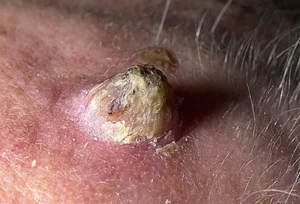Precancerous Skin Lesions
Precancerous skin lesion or symptom is a step just prior to cancer: considered as a warning by the body before un-repairable loss or damage i.e. threat. Precancerous skin lesions is the Skin growth with high turnover into deadly skin cancer. Immunotherapy has been proved to be a promising arm in treating various cancerous as well as precancerous conditions.
Examples of Precancerous skin lesions:
1. Lentigo maligna with the next stage as Malignant melanoma
2. Actinic keratosis with next stage into squamous cell carcinoma
Well! You all must be wondering what is benefit to differentiate all these conditions as precancerous if its next stage is already malignant in nature.
Let’s have a view about preventing cancer to rule over if diagnosed at the early or precancerous stage:
Dr. Sajjan Rajpurohit has his expertise in Immunotherapy and is practicing it on the large beneficial scale;
Today he wants to enlighten us about Immunotherapy in Precancerous Skin Lesions
Warning Signs of Skin Cancer at early stages in the form of precancerous lesions: (changes to skin – don’t let it go unnoticed)
New growths or precancerous lesions (changes not cancer but tendency to become cancer over time if left untreated)
Approximately, as per data reported in the literature, 55% of fair-skinned people develop at least one skin cancer.
How to spot the early warning signs as skin cancer can be cured if it’s found and treated early:
The Warning Signs of Skin Cancer
Skin cancers — including melanoma, basal cell carcinoma, and squamous cell carcinoma — often start as changes to your skin. They can be new growths or precancerous lesions — changes that are not cancer but could become cancer over time.
An estimated 40% to 50% of fair-skinned people who live to be 65 will develop at least one skin cancer. Learn to spot the early warning signs. Skin cancer can be cured if it’s found and treated early. some
An estimated 40% to 50% of fair-skinned people who live to be 65 will develop at least one skin cancer. Learn to spot the early warning signs. Skin cancer can be cured if it’s found and treated early
Some Precancerous Skin Lesions are as follows:
1. Actinic Keratosis (Solar Keratosis)

• Symptoms and signs: small, scaly patches
• Risk factors: excessive sun exposure, Fair-skinned, blond, or red-haired people with blue or green eyes
• Common site affected: head, neck, or hands
• Recommend: early treatment to prevent the development of squamous cell carcinoma of the skin
• Can be treated by Immunotherapy: yes
2. Actinic Cheilitis (Farmer’s Lip)

Common site: lower lips. Scaly patches or persistent roughness of the lips Signa and symptoms: include swelling of the lip, loss of the sharp border between the lip and skin, and prominent lip lines.
Recommend: early treatment to prevent evolving into invasive squamous cell carcinoma Can be treated by Immunotherapy: YES
3. Cutaneous Horns- Precancerous Skin Lesion

Appearance: a funnel-shaped growth with a red base
It is a specialized type of actinic keratosis. Size and shape: can vary considerably
Squamous cell carcinoma can be found at the base. Risk Factors: fair-skinned elderly adults with significant sun exposure. Recommended: see a doctor
4. Atypical Moles

When Is a Mole a Problem? Pre-cancerous skin lesion: Dysplastic Nevi (Atypical Moles) Site of occurrence: sun-exposed or sun-protected areas of the body. Signs: larger (one-quarter inch across or larger), irregular in shape, notched or fading borders, flat or raised, surface smooth or rough Colour: mixed color, including pink, red, tan, and brown.
To screen mole if it has the capacity to tun into Melanoma or when to see a doctor?
RULE: Know Your ABCDEs:
‘A’ is for Asymmetry: one half of a mole does not match the other half.
‘B’ is for Border: ragged, blurred, or irregular ‘C’ is for Color: A mole that does not have the same color throughout D’ is for Diameter: diameter is larger than the eraser of a pencil (Suspicious) ‘E’ is for Evolving: shrinking, growing larger, changing color, begins to itch or bleed
Follow Tips for Screening Moles for Cancer:
- Regularly Examine your skin.
- Be especially suspicious of a new mole.
When to pay special attention to your moles:
- Teen
- Pregnant
- Going through menopause
Recommend: If you find a mole with even one ABCDE’s of melanoma -see a doctor.
Immunotherapy in precancerous skin lesions:
•Topical calcipotriol plus 5-fluorouracil (5-FU) combination is effective immunotherapy:
o Targeting precancerous lesions with robust T-cell-directed immunotherapy can yield effective cancer prevention as per the reported literature where now it appears that we can achieve a reduction of the chance that the treated skin will develop squamous cell carcinomas, the second most common form of skin cancer. This is well achieved in Actinic keratosis and actinic cheilitis
• Ipilimumab is an anti-CTLA-4 inhibitor:
o It a checkpoint inhibitor that helps your own immune system attack cancer cells. Helps in Major regression of multiple atypical melanocytic nevi is achievable.
• Topical Immunotherapy has become the standard of care for patients that helps in managing skin and nail changing during cancer treatment as well.
Above examples explain the vast role of developing field of immunotherapy where our own immune cells are used against cancer cells in damaging our body
For details contact Dr. Sajjan Rajprohit
LETS WELCOME IMMUNOTHERAPY AS NUCLEAR BOMB IN WAR AGAINST CANCER
Also read:
How does immunotherapy work for cancer treatment?
Which cancers are treated with immunotherapy? Types of immunotherapy used to treat cancer.




